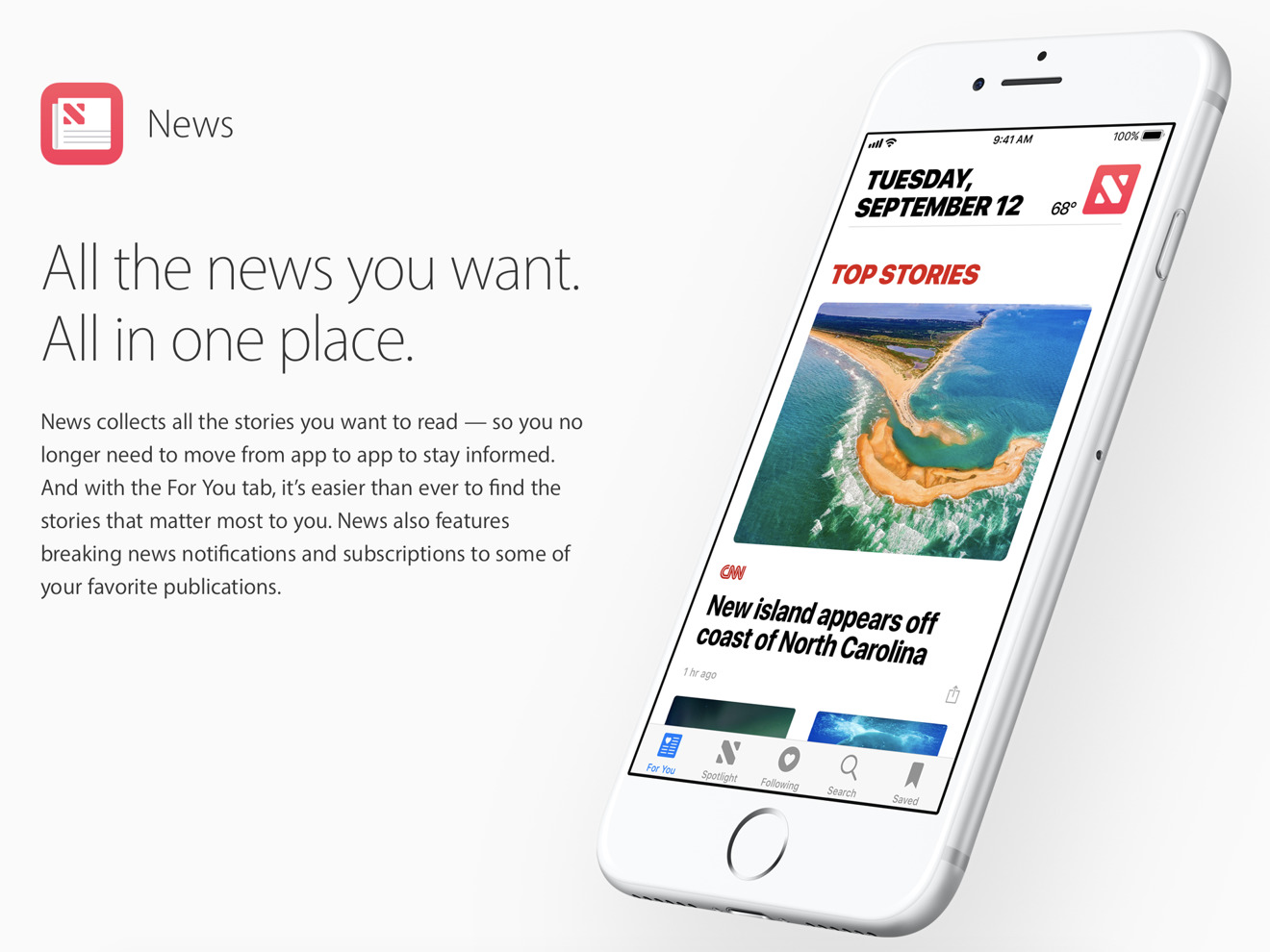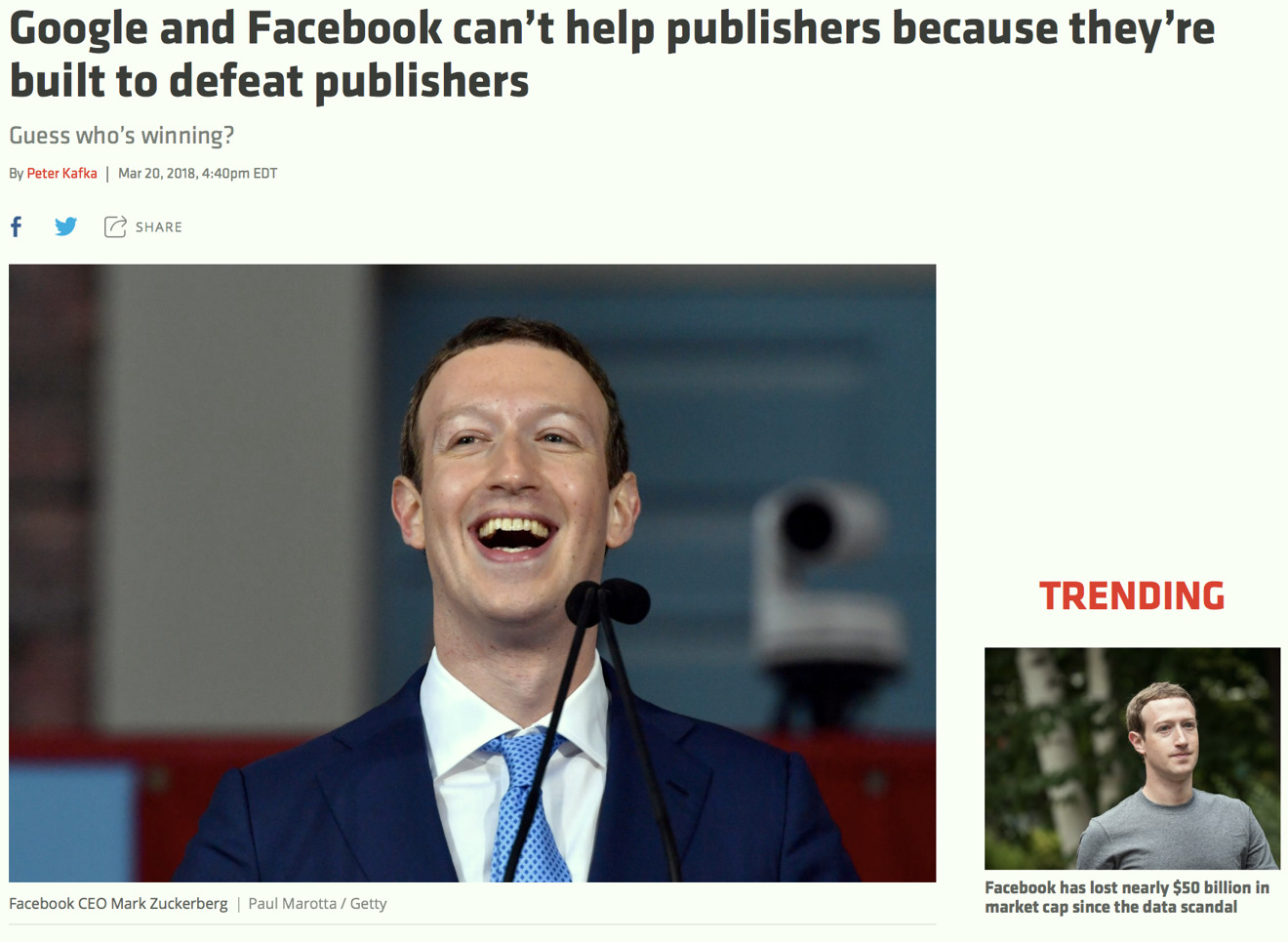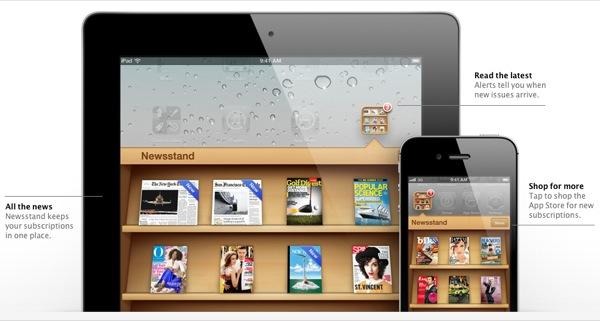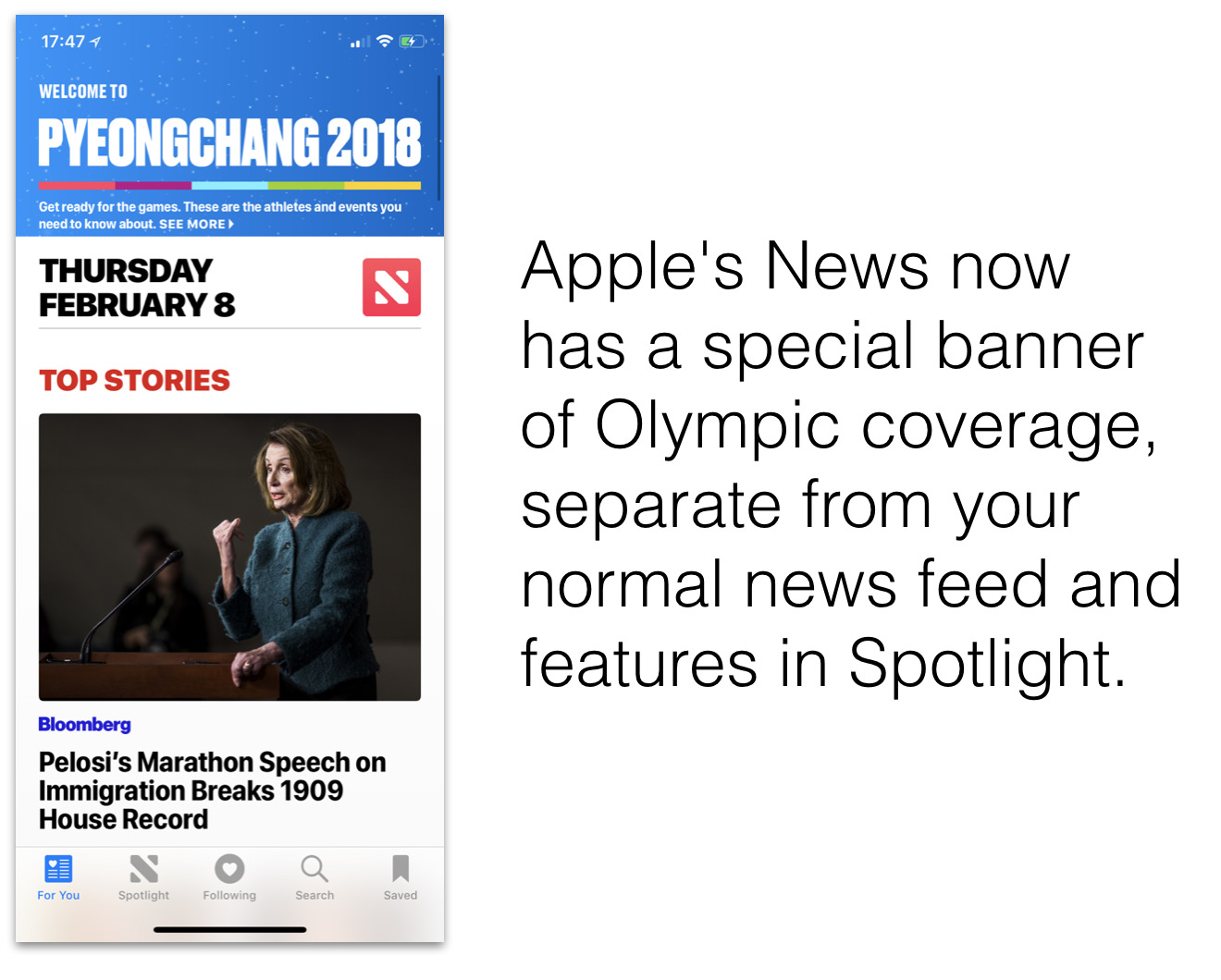After Cambridge Analytica scandal, publishers see Apple News as a solid alternative to being burned by Facebook, Google
For years, Facebook and Google have been bleeding the publishing industry dry, appropriating the work of its reporters while replacing the ads that traditionally supported the news business with their own targeted surveillance advertising that does little to support actual journalism. It took a major scandal to wake the industry up, but it's increasing warming to Apple News and its unique model of privacy.
The exposure of how Cambridge Analytica was able to obtain private data on 50 million Facebook users without permission, and why Facebook did nothing for two years after finding out about the egregious misuse of the massive social graph it maintains, has awakened a "Delete Facebook" movement among users tired of web advertising's malicious incompetence running roughshod over any remaining notion of online privacy and digital security.
But it's also a wakeup call to news publishers, who have long partnered with Facebook and Google with the expectation that all of the surveillance data those advertisers collect would eventually be of benefit to publishers, rather than just continuing to take away the revenues that have historically supported journalism.
Facebook and Google are "built to eviscerate publishers"
Today, in a piece for Recode headlined, "Google and Facebook can't help publishers because they're built to defeat publishers," Peter Kafka wrote, "no matter how hard Google and Facebook try to help publishers, they will do more to hurt them, because that's the way they're supposed to work. They're built to eviscerate publishers."
Unlike Facebook and Google, which rely entirely upon advertising revenue and have been working to take as much funding as possible away from their news partners, Apple developed its iOS News app with the same goal as the App Store and iTunes: to make its premium hardware more attractive and engaging to customers by surrounding it with ecosystems of valuable content from many sources.
Apple's efforts to bring valuable curation and publishing tools to online journalism have been gaining ground since the release of its News apps as part of iOS 9. Publishers can choose to work with Apple to monetize their work, or use their own ad technology. It's becoming an increasingly attractive option for news publishers as they realize what a mistake they made to partner with Facebook and Google.
Apple News is helping news sites building traffic, find subscribers
In February, The Information published a report by Tom Dotan titled "Inside Apple courtship of news publishers," noting that "Apple News has generated half of Vox.com's daily traffic at times."
The traffic itself isn't necessarily generating revenue, but publishers are learning how to convert readership into paid subscriptions. A report by Digital Content Next cited Dave Merrell, a lead product manager at The Washington Post, as outlining Apple's iOS demographic as a particularly valuable segment of readers.
Merrell said the Post has "had a subscription offer in Apple News since the launch of iOS 10, and we have been pleasantly surprised by this audience's propensity to subscribe. After only a year, Apple News is a thriving subscription channel for us."
He also noted, "Apple News traffic and subscriptions didn't just fall into our lap. We recognized the opportunity of a news platform built directly into iOS and made Apple News an integral part of our editorial processes immediately. We spent a lot of time studying the Apple News audience and their habits, and our editors watch Apple News analytics every day in order to ensure that audience is getting our best journalism."
Apple is actually quite well positioned to help publishers.
— Ben Bajarin (@BenBajarin) March 21, 2018
Apple News is secretly a powerful platform for publishers. https://t.co/1TejYBSElA
David Lee, a Silicon Valley reporter for the BBC, tweeted yesterday that Apple News is a "Massive traffic driver for us. Particularly video."
Apple vs the surveillance advertisers
Apple's initial efforts to support journalists and news publishers with a digital periodical model focused on iPad was collectively jeered at by the news industry, which largely wanted to suck up unlimited data on their readers and use that to target them for new revenues in the web model they'd been adopting.
They generally saw Apple as standing in the way of their cherished cookies, and most refused to support a digital medium for journalism that offered less access to reader analytics and behavior than Google's surveillance ads had been offering them on the web.
When iPad first shipped in 2010, news publishers were also largely wedded to the idea of using Adobe Flash to deliver a digital facsimile of their print publications. Rather than adopting Apple's model for delivering HTML5 content or building custom iOS apps (the way conventional PC software makers successfully did), major publishers including Cond Nast worked with Adobe to throw out "something very lazy and/or desperate," effectively huge, unwieldy images of their magazines packaged in an app wrapper.
When customers passed on paying for lazy, poorly implemented subscription-based apps that offered nothing new that couldn't already be found elsewhere, often for free, publishers complained that it was Steve Jobs' fault for not singlehandedly saving journalism on their behalf.
Apple's rough path to the News app
In 2011, Apple promoted "The Daily," an effort to tailor news for iPad users by Rupert Murdoch's News Corp. Yet it was competing against, essentially, Napster-News, an endless array of legitimate (and less legitimate) news sites offering content on the web or in apps for free, generally monetized by display adverting from Google. Even at its 99 cents per week price, "The Daily" wasn't enough to capture enough readers' attention to sustain a newsroom of journalists working to create professional content for it.
The next year, Apple focused on iPad digital books to take on the textbook industry, an effort that resisted by textbook publishers as well as attacked by Amazon. Despite being the leading digital bookseller with majority market share, Amazon successfully complained to the federal government that Apple had colluded with publishers to sell ebooks priced higher than the prices it was capable of forcing publishers to sell their work for.
Apple spent several more years working on a publishing strategy for news, starting with "Newsstand," a dedicated iOS folder for news-related App Store titles, with a specialized store designed to highlight subscription-based content. This too didn't gain much traction in a world where plenty of other content was available for free online, and most news apps were simply lazy wrappers for huge images of print magazines.
Creative App Store developers, however, began working on new ways to present interactive, digital book and magazine layouts. Former Apple employees Mike Matas and Kimon Tsinteris launched Push Pop Press with the intent of facilitating the creation of dynamic books as native iOS apps.
After Apple appeared interested, Facebook bought the startup in 2011 and flubbed its own execution in trying to launch the concept as Paper. It didn't launch until in 2014, and was then abandoned by Facebook after two years.
In 2012, a digital publisher in Netherlands, led by Michel Elings, relaunched its formerly Adobe InDesign-based TRVL publication as an iOS-native digital app with interactive features, created using a the Prss development tool it custom built for the task.
The slick app and the technology behind it also caught Apple's attention. It highlighted the team's work in 2012 at WWDC, and it subsequently ended up acquiring the team by the end of 2014.
The following year Apple released iOS 9 with a new Apple News app replacing Newsstand, with features that appear to derive from Prss. At the time, Apple also stressed that News readers' personal behaviors and recommendations would not be tracked or linked to their Apple ID.
Since then, Apple has expanded the curation and customization of News feeds, allowing users to set up notifications for breaking news, select news sources or subjects of interest similar to the recommendation system in Apple Music, subscribe directly to publications, search for news by subject and save articles for reading offline later.
Apple News also began managing an updated Spotlight of related, trending stories of the day and has added specialized coverage for events including the recent Olympic Games (above).
Earlier this month, Apple acquired Texture, an app that offers instant digital access to both new and legacy issues of around 200 of the most popular publications. Its unlimited access subscription model has been dubbed the "Netflix of magazines," and appears to fit into Apple's increasing interest in building a content empire beyond Apple Music and iTunes Movies and Apple TV.
The company may reveal more about its iOS news and book publishing efforts at its education-related event being held next week in Chicago. It is also likely to outline more about its plans for News, digital publishing, social networking and its ongoing privacy initiatives at WWDC in June.
 Daniel Eran Dilger
Daniel Eran Dilger














 Mike Wuerthele
Mike Wuerthele
 Malcolm Owen
Malcolm Owen
 Chip Loder
Chip Loder

 William Gallagher
William Gallagher
 Christine McKee
Christine McKee
 Michael Stroup
Michael Stroup
 William Gallagher and Mike Wuerthele
William Gallagher and Mike Wuerthele






